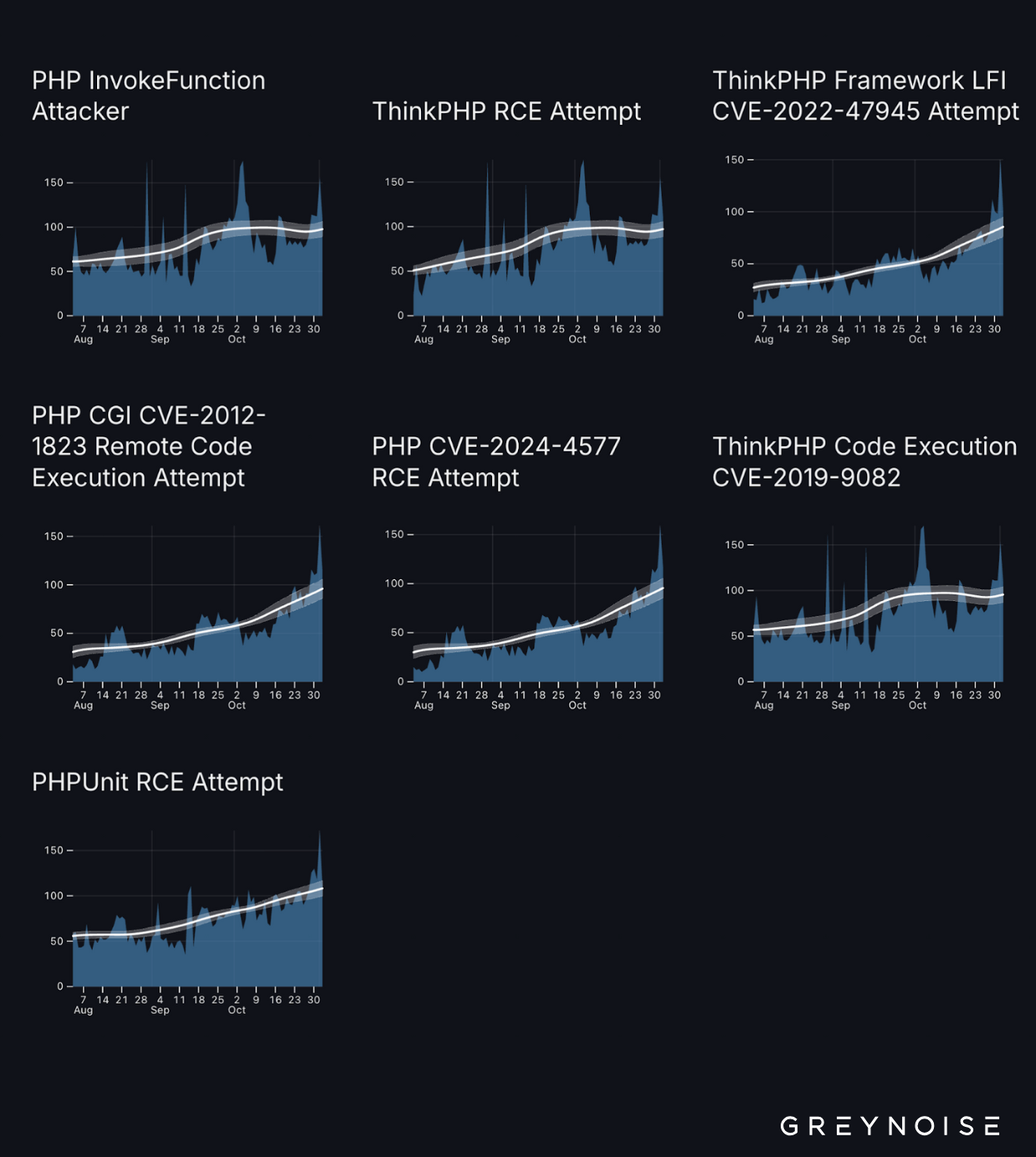What we’re seeing
From August through October 2025, we observed (GreyNoise Visualizer) a clear ramp-up in exploitation attempts against PHP and PHP-based frameworks as actors push to deploy cryptominers. The query below captures a range of attempts (ThinkPHP, PHP CGI, PHPUnit, the recent PHP CVE-2024-4577, etc.), and the telemetry shows seven distinct attack patterns that move in parallel: steady in August–September, then spiking into October and November.

The loudest campaigns exploit ThinkPHP Framework LFI (CVE-2022-47945), PHP CGI (CVE-2012-1823), and PHP CVE-2024-4577, all of which show steep growth. Older chains (ThinkPHP Code Execution CVE-2019-9082, PHPUnit RCE) still produce meaningful volume—roughly 50–150 attempts per day—and the network graph implies these campaigns aren’t independent: they share infrastructure and tools, pointing to coordination or communal tooling.
The infrastructure behind the attacks
Cloud providers constitute the majority of attacking IPs. Top offenders by IP count include Cloudflare (1,000 IPs), DigitalOcean (688), Google (536), and Contabo (512). The top 21 organizations account for about one-third of all attacking IPs—a mix of compromised customer VMs, misconfigured services, and rented infrastructure used for mining at scale.

Geographically, the attacks are global: German hosters (Contabo, Hetzner), Taiwanese carriers, and Chinese cloud platforms (Beijing Volcano Engine, Huawei, Alibaba) alongside large North American providers. Attackers are simply using whatever compute they can either rent or compromise.
Why now: the cryptocurrency economics
Timing matters. With Bitcoin trading above $110,000 and the crypto market cap over $3.71 trillion, the math for miners is attractive. November has historically been a strong month for Bitcoin—the dataset going back to 2013 shows outsized gains in November (some years dramatically so). If Bitcoin rises from $70k to $110k, identical mining power suddenly produces ~57% more revenue.
Market projections referenced here are bullish—some analysts have mid-month price targets in the $120k–$125k range, and a few institutions have higher year-end targets. Monetary policy has also loosened recently: a 25-basis-point Fed cut in early November, the prospect of another cut in December, and an announced end to quantitative tightening on December 1 all increase liquidity that can flow into risk assets. Those conditions make mining more profitable now than a few months ago.
For attackers, that’s a simple incentive: higher price = higher payoff for the same stolen CPU cycles. They’re trying to scale into the window of maximum short-term profitability.
The economics of cryptojacking
Cryptomining is attractive because its economics favor stealth and scale. Unlike ransomware, which requires victims and payment infrastructure, mining converts compute to coin with minimal friction. There are no negotiations, no human-in-the-loop—just silent revenue flow.
Cloud cryptojacking activity rose roughly 20% in 2025, showing that mining is now a commodity crime. The playbook is straightforward: scan, compromise, deploy a miner (binary, Docker image, or script), and funnel rewards to mining pools controlled by the attackers. Victims pick up the electricity and infrastructure cost while attackers collect the proceeds.
The barrier to entry is low: exploit kits, prebuilt miners, and scanners are widely available. Often, a successful chain of automated steps—probe, exploit, payload fetch, execute—is all that’s needed to get mining capacity online.
Why PHP and internet-facing systems
PHP is everywhere: from tiny CMS installs to large web apps. Many sites run unpatched or old framework versions, and ThinkPHP—popular in parts of Asia but also found globally—shows up frequently in these campaigns.
The exploited vulnerabilities span a lengthy timeline (2012–2024), highlighting a core problem: old vulnerabilities don’t go away just because they’re old. Organizations patch parts of their stack, but legacy frameworks and forgotten installs remain exploitable. That persistence creates a reliable attack surface.
Internet-facing servers are preferred mining targets because they have more compute, run continuously, and often tolerate high resource use—so miners get better yield and longer uptime than they would from end-user devices.
Why PHP matters in a cybersecurity context
- Ubiquitous: Powers ~75% of websites; even if you don’t use it, your partners and vendors do.
- High-value target: Exploits in PHP apps (like WordPress or Drupal) are a top initial-access vector.
- Low visibility: Web servers running PHP are frequently unmonitored and outdated—perfect entry points.
- Common tradecraft: Criminals and nation-states alike use PHP web shells for persistence and lateral movement.
- Operational takeaway: Inventory, patch, and monitor PHP systems—don't let “legacy web” become your soft underbelly.
The operational pattern
These campaigns use methodical internet scanning to find vulnerable PHP installs. Exploitation is typically automated; the same exploit will successfully target hundreds or thousands of identical stacks. Cryptominer deployment follows a standard recipe and is typically fully automated.
Because mining doesn’t exfiltrate sensitive data or immediately crash systems, it can persist for long periods. The miner quietly consumes CPU/GPU cycles and reports work to attacker-controlled pools. Victims notice degraded performance and higher costs long before they realize they’ve been harvested for crypto.

The network graph demonstrates interconnected operations: different vulnerability chains (PHPUnit RCE, ThinkPHP, PHP CGI) share infrastructure, which suggests either a single large group or multiple groups reusing the same toolsets and pool infrastructure.
The November window
This is early November 2025—historically a strong month for Bitcoin and, given current prices and recent monetary easing, an attractive window for miners. The activity spike through September and October looks like positioning: compromise now, mine during the high-value period.
If November follows historical patterns and prices climb materially, deployed miners will earn significantly more than they would have months earlier. The Fed’s easing and the end of QT add a tailwind for risk assets, further reinforcing the incentive for attackers to maximize deployed capacity now.
What’s actually happening
Put bluntly, it’s volume economics. Scan thousands, compromise hundreds, deploy miners, and collect coins. The exploited PHP vulnerabilities range from trivial to complex, but automation compresses the skill requirement. Mining software and scripts are standardized; collection is automated via pools.
The campaigns we see are industrial in scale. Over 1,700 attacking IPs from major cloud providers suggest large botnets or significant rented infrastructure. Upward trends show successful scaling. Shared infrastructure and tooling point to coordination or a robust community market for exploitation and deployment tools.
Computing power → cryptocurrency → monetary value. When that chain lines up with favorable market conditions, criminal actors respond rationally: they increase mining capacity and run it while the window is lucrative.










.png)
.png)